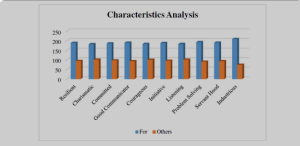In recent years, there has been a notable shift in the landscape of top strategic management positions, with an increasing recognition of the importance of gender diversity in leadership roles. Women are making significant strides in attaining and excelling in top strategic management positions across various industries. The purpose of this study is to explore the evolution of women in top strategic management positions.

Women in Top Strategic Management Positions
Table of Contents
Toggle1. Breaking the Glass Ceiling:
- Historical Challenges: Traditionally, women faced challenges in breaking through the glass ceiling, hindering their access to top leadership roles.
- Shifting Norms: Evolving social norms and a growing awareness of the benefits of diversity have contributed to a more inclusive approach in strategic management.
2. Corporate Boards and Executive Suites:
- Board Representation: Efforts have been made to increase the representation of women on corporate boards, recognizing their valuable perspectives in shaping organizational strategies.
- Executive Leadership: Women are ascending to executive leadership roles, including Chief Executive Officer (CEO) and Chief Operating Officer (COO) positions.
3. Industries at the Forefront:
- Technology: The technology industry has seen notable female leaders, with women taking on strategic roles in major tech companies.
- Finance: Women are increasingly occupying top positions in finance, influencing strategic decisions in banking, investment, and financial services.
4. Global Recognition:
- Global Recognition: Internationally, women are gaining global recognition for their leadership in strategic management, breaking barriers in traditionally male-dominated sectors.
- Inspirational Figures: Female leaders in strategic management serve as inspirational figures, encouraging future generations of women to pursue leadership roles.
5. Entrepreneurship and Startups:
- Entrepreneurial Landscape: Women entrepreneurs are establishing and leading successful startups, contributing to innovation and reshaping industries.
- Venture Capital: Women in strategic management positions play pivotal roles in venture capital, influencing investment decisions and fostering a diverse startup ecosystem.
6. Cultural and Organizational Shifts:
- Cultural Dynamics: Cultural shifts within organizations are recognizing the need for diverse perspectives at the highest levels of decision-making.
- Organizational Initiatives: Many companies are implementing initiatives to promote gender diversity, including mentorship programs and leadership development opportunities for women.
7. Impact on Organizational Performance:
- Studies and Reports: Research suggests that gender-diverse leadership positively impacts organizational performance, innovation, and overall resilience.
- Corporate Governance: Companies with women in top strategic management positions often exhibit strong corporate governance practices.
8. Ongoing Challenges:
- Persistent Gender Gaps: Despite progress, gender gaps persist, and women continue to face challenges in achieving parity in top leadership roles.
- Representation in Specific Sectors: Some industries still lag in achieving equal representation, highlighting the need for continued efforts.
9. Advocacy and Support:
- Advocacy Groups: Advocacy groups and movements championing gender equality in the workplace contribute to the ongoing dialogue and efforts to address barriers.
- Mentorship and Networking: Mentorship and networking play crucial roles in supporting women’s career progression into strategic management positions.
10. Future Outlook:
- Continued Progress: The trajectory indicates continued progress, with organizations recognizing the strategic value of diverse leadership teams.
- Role Modeling: Women currently in top strategic management positions serve as role models, inspiring future generations to pursue leadership aspirations.
In the evolving landscape of strategic management, the increased representation of women in top positions signifies a positive shift towards diversity, inclusivity, and a richer tapestry of leadership perspectives. As women continue to ascend to these roles, their influence on organizational strategies and decision-making is poised to grow, contributing to a more dynamic and effective strategic management landscape.
